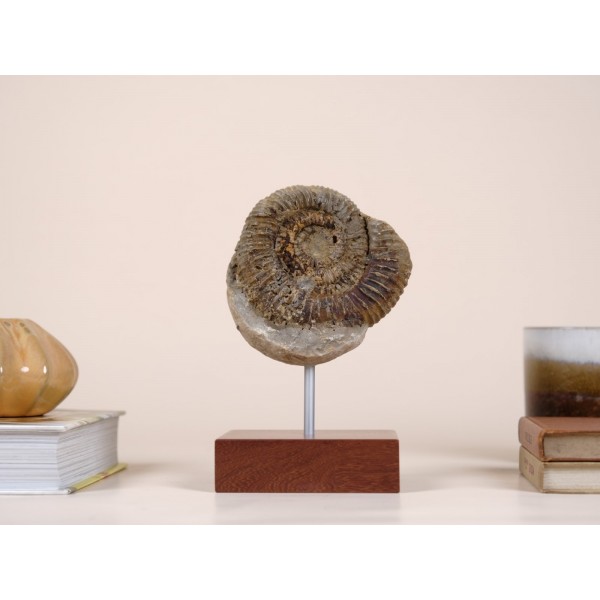Petrified wood trunk
Araucaria trunk piece from the famous Ambilobe Petrified forest in Madagascar.
These are formations from the Triassic period with around 220 million years.
Mounted in an acrylic base is a beautiful historic piece!
| close |
This shop uses cookies to improve your experience on our website. |
Reference: N1040
Perisphinctes sp. Ammonite from late Jurassic Period (160 million years), mounted in a exotic Tacula wood base.
Beautiful natural composition, from Sakahara fields in Southwestern Madagascar.
Dimensions: 19 cm x 10 cm // Base: 10 cm x 10 cm x 3 cm
Weight: 1 Kg

Perisphinctes sp. Ammonite from late Jurassic Period (160 million years), mounted in a exotic Tacula wood base.
Beautiful natural composition, from Sakahara fields in Southwestern Madagascar.
Araucaria trunk piece from the famous Ambilobe Petrified forest in Madagascar.
These are formations from the Triassic period with around 220 million years.
Mounted in an acrylic base is a beautiful historic piece!
Balanocidaris glandifera - fossil sea urchin - Carapace with radiolas, in a acrilic base.
Excellent fossil of a sea urchin in life position. The hedgehog and spines have preserved the finest details and have been carefully arranged in a living position. The radiolas preserve the original colouring patterns. It is a fossil worthy of a museum.
Sea urchin with spines up to 11 cm, from Upper Jurassic, Kimmeridgian (152.1-157.3 million years) - France.
Cretaceous Albian period (100 to 145 million years) from Madagascar.
Spectacular big size opalized Cleoniceras group with other ammonite specie.
One of a kind decor piece!
Carcharocles megalodon - Neogen - Miocene, Burdigalian (15.97 - 20.44 million years) - Indonesia. A huge, extra large and superb tooth, with a wonderful colouration, as characterise the megalodon of Indonesia. Beautiful teeth with a colour very similar to those of Chile and Peru, deposits closed for a long time. These megalodons have been on the market very recently.
Superb, unbroken slab filled with wonderful naturally occurring orthoceras fossils that was once part of the prehistoric ocean floor over 400 million years ago.
As these forms of prehistoric squid were covered in ocean sediments prior to fossilization, the majority of the creatures will be facing in the same relative position, having been lined up by currents on the sea floor prior to being buried.
The fossils are exposed and given a high polish to better view the creatures from their surrounding matrix. The slab features very high relief as well as dramatic texture and detail they had tentacles and ink sacs, much like present-day squid.
Except for belemnites, cephalopods had external shells with hollow internal chambers separated by walls called septa.
Devonian period, circa 410 million years, Anti-Atlas Mountains - Southern Morocco.
Pleuroceras solare - Pyritised Lower Jurassic Ammonite from Germany, mounted in a black high gloss lacquered wood base.
A pyritised ammonite, which has been brass brushed to enhance the golden colour.
Hawskerense Subzone, Spinatum Zone, Middle Lias, Lower Jurassic, Butterheim, Germany Age:- 190 Million Years Old Ammonite.
A huge, beautiful coloured Douveilliceras mammilatum from the Albian period, Upper Cretaceous (110 million years) of Mahajanga Province - Madagascar.
A perfect piece for decor, mounted in a handmade wood base.
Nicaisolopha nicaisei from Upper Cretaceous of Cajamarca Peru, mounted in a white lacquered wood base.
An exceptional Museum Quality slab with five Gigantopecten restitutensis fossil from Vaucluse quarry in S.E. France.
Lower Miocene (Burdigalien), around 20 to 16 million years.
It is very well prepared and clean, a "one of a kind" piece!
Cretaceous Albian period (100 to 145 million years) from Madagascar.
Spectacular big size opalized Cleoniceras group with other ammonite specie.
One of a kind decor piece!
Carcharocles megalodon - Neogen - Miocene, Burdigalian (15.97 - 20.44 million years) - Indonesia.
A large and superb tooth, with a wonderful colouration, as characterise the megalodon of Indonesia.
Perisphinctes virguloides ( Ammonite ) Pair in acrylic base. A beautiful pair of this elusive fossil specimen from the Madagascar Upper Jurassic ( +/- 180 million years ) still very good structure details.
A good collection starter.
Crotalocephalus gibbus fossil Trilobite, a spectacular piece featuring a perfect dorsal view, still embedded in its original matrix. Skillfully prepared, this fossil is well preserved, 100% natural, and sandblasted with no restoration or added trilobite spines or paint.
Dating back to the Lower Devonian period, Landhar formation, Pragian stage (410 – 407 million years), this specimen was recovered from Aatchana, Errachidia Province, Morocco.
It is mounted on a black lacquered double wood base.
A slice of petrified tree, mounted on a handmade brass support.
It comes from the Tsingy de Bemaraha National Park in Madagascar.
Great pattern and colours. A one of a kind piece.
Phacops sp. from the Middle Devonian period ( 395 million years ) of the Djebel Issoumour area, Atlas Mountains - Morocco.
Prepared and restored, excellent for beginner collectors or as decor piece, in an acrylic base.
A superb Scyphocrinites elegans in a rose marble base.
A One of a Kind piece, from Permian period (358 to 419 million years) of Erfoud - Morocco, an extinct genus of crinoid Camarocrinus.
Beautiful fossil slabs colors and pattern made an extraordinary decor piece.